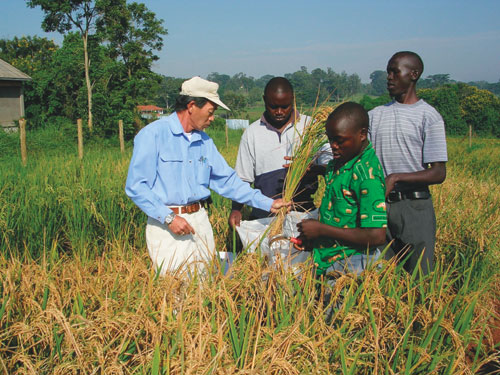Japan's Official Development Assistance White Paper 2005
Column II-4 People Benefiting from NERICA
Recently in Sub-Saharan Africa, the consumption of rice, which can be cooked easier than corn, potatoes, or grains, has been increasing mainly in the urban areas. However, the amount of rice imports from Asia has risen in many countries there, because domestic rice production is not enough to meet the increasing demand. Against this backdrop, NERICA (New Rice for Africa), which has higher yield compared to the traditional one, attracts great attention as a promising species aimed at increasing rice production.
NERICA is new rice species that has been developed through cross-breeding disease- and drought-resistant African rice species with high yield-potential Asian rice species. NERICA possesses, therefore, the beneficial characteristics of both. Japan has strongly supported the research, development, and dissemination of NERICA in cooperation with international organizations, such as the West Africa Rice Development Association ( WARDA ) and the UNDP.

An expert providing technical guidance on the cultivation of NERICA (Photo: JICA)
The government in Uganda, a country located in East Africa, actively promotes the production of NERICA. Nonetheless, the knowledge and experience related to rice cultivation technology is still insufficient in the country. Thus, it is necessary to improve the technical skills of the local farmers by providing training and introducing cultivation manuals, post-harvest treatment methods (threshing, wind selection and drying) and farm tools, etc. Currently, to Uganda, JICA dispatches agricultural specialists, who provide guidance on NERICA cultivation methods and training on the manufacturing of threshing equipment in cooperation with NGOs. As a result of such assistance from Japan and dissemination activities of the NGOs, as well as the production and sale of seeds by private companies, NERICA cultivation has spread rapidly. In Uganda in 2002, the cultivation area of NERICA was merely about 1,500 hectares, but has currently grown to an estimated more than 10,000 hectares. Receiving trainees from other East African countries for observation and training, Uganda has come to be a basis for NERICA dissemination in East Africa.
Mr. Robert Waiwa, the head of the "Bubago 1 Multipurpose Farmers Group," one of the farmer's unions in Uganda, began cultivating NERICA in 2001. With the commencement, he established the farmers' union to loan seeds, promote cooperation and exchange information with neighboring farmers. Currently the number of union members has increased to 35 (20 males and 15 females), and the cultivation area, which was originally around 1.2 hectares, has grown to approximately 32 hectares.
Mr. Waiwa says, "Because we started cultivating NERICA, we are now able to sell rice of higher quality and price compared to corn or millet. Our income has increased, and now we can pay for our children's education and medicine. With the establishment of a farmers' union, the level of farmers' cultivation technology has gone up. I am grateful for the development and dissemination of NERICA."


 Next Page
Next Page